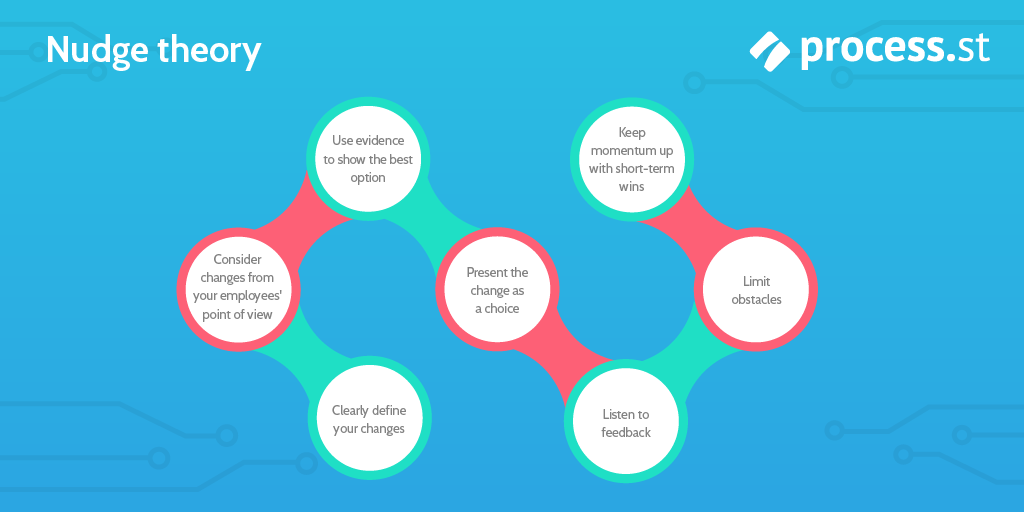The Nudge Theory is very relevant when we speak of Change Management, even if it is not, strictly speaking, a Change Management model. To a certain extent, it is more of a mindset based on strong behavioural evidence about what can help in making Change happen and stick.
The Theory has gained relevance globally thanks to the book Nudge: Improving Decisions About Health, Wealth, and Happiness written in 2008 by Richard H. Thaler, Cass R. Sunstein. They built much of their Theory on the ‘heuristics’ work of Israeli-American psychologists Daniel Kahneman and Amos Tversky, which first emerged in the 1970s in psychological journals, and where later crystallised in the book by Kahneman Thinking, Fast and Slow.
The concept of Nudge is based firmly on the concept of “Choice”, and how we, as Human Beings, think of the choices we make. Used for ages in Marketing, Advertising and Management, the concept of Nudging is beneficial across several scenarios when managing and leading Change.
When applied to a change project, the Theory shows its effectiveness in the idea that “nudging” people to change is much more useful than trying to enforce Change based on more traditional practices. The use of Nudge theory is based on indirect encouragement and enablement. It avoids direct instruction or enforcement. Instead of telling people to change, you pave the way for them to choose to do so by themselves. But how?
Fundamentally (and appropriately, according to its origins) Nudge theory operates by designing choices for people who encourage positive, helpful decisions; for the people choosing, and ideally for the broader interests of society and environment, etc.
A Nudge is essentially an action that is indirect, subtle, open-ended, educational, backed up with evidence, optional, and open to discussion. The Nudge Theory provides a framework for this, but not strict guidance on how to achieve the result. In the context of Change Management, we can identify some basic principles to apply when “nudging” change.
- Clearly define your changes
- Consider changes from your employees’ point of view
- Use evidence to show the best option
- Present the Change as a choice
- Listen to feedback
- Limit obstacles
- Keep the momentum up with short-term wins
These are often understood also in the framework of other heuristic elements we have already seen: biases. If you want to utilise the Nudge Theory, you need even to know that component of human behaviour.
The Nudge Theory applied to Change Management

1. Clearly define your changes
The first step, similarly to other models, is to bring clarity to what you want to achieve with the Change process. If you’re going to indeed enlist your full team as a clear sponsor and supporter of the Change, you need to ensure transparently what you aim to achieve. One of the biggest misunderstandings about Nudging is that is seen as a form of manipulation. Although some individual nudging techniques can be used to trigger responses from individuals against their will, these can only be applied in short term reactions. Here we need to develop lasting relationships, thus the need for absolute transparency.
2. Consider changes from your employees’ point of view
Understanding the employee’s point of view is critical at this stage. Think about the elements you should already be aware of (such as culture, structure, jobs and role design) and complement this with an in-depth understanding about skills levels, knowledge and emotional commitment, and try to imagine their reaction to change.
Then, try to elaborate on one or more scenarios where Change is achieved, but the process to get there is done in a more desirable way for your employees. Desirability is critical here, but don’t think just in terms of time. Often it is a question to find the process that best highlights the benefits for the individuals involved in the process.
3. Use evidence to show the best option
Scenarios elaborated need to be supported by sharp evidence to prove that the suggested option is the best one. This step is often ignored by most Change Management methods, that are concentrated on one log term vision, and they tend to go immediately into execution usually.
Evidence can be linked to Performance, as well as to other elements that support the change decision and the path to achieving this. Using an evidence-based approach will also allow you to justify the chosen option vs different possible change paths, that are identified as less desirable.
4. Present the Change as a choice
The three above steps allow to implement the real core moment of the Nudge theory, i.e. let people choose Change. By using the multiple options identified, the employee’s point of view and all the evidence in support, people will have all the tools to make their choice and support the Change project.
By becoming a Conscious Choice, the change process will gain the commitment of the individuals that are involved. This is also why this step can start a loop. If you get a rejection, again you can’t force the process. Still, you should move back to question if a) you have examined all possible scenarios, b) you are clear with your goals and c) you have identified enough substantial evidence.
5. Listen to feedback
Whether your Change was rejected or not, you need to be open to whatever feedback your team may have. You might have missed a possible alternative or an effect that the Change might have on current operations. Your team is the best suited to find these issues and warn you so that actions can be taken to limit the problems themselves.
Listening to feedback also will make people more valued (especially if then actions are taken in alignment with the feedback themselves).
6. Limit obstacles
One of the biggest hurdles in change processes is the fact that we often make lives miserable for the people that are going through the change process itself because we don’t adapt processes and policies that might impact them. How often did you have issues during testing for a new system, simply because you were applying the same security policies meant for the live environment?
It is essential to think about all the possible obstacles both before the start of a change process and during the process itself, trying to remove all the barriers you can. You can’t identify everything from the beginning, so make sure you also remove those that you intercept through the feedback of your teams.
Any roadblock can diminish the team’s commitment to achieving. Showing consistent effort removing obstacles will also make it possible to justify occasionally those that cannot be removed.
This way, transitioning to the new way of working will be more uncomplicated and more comfortable, and require less energy distraction from the team members.
7. Keep the momentum up with short-term wins
Once you are on the path to achieving Change, make sure you celebrate all the small victories on the way. The problem with long term change goals is that it is difficult to sustain the effort for an extended period without reward. This does not need to be monetary; sometimes, it is just about recognising that a step has been achieved.
For this reason, it is essential to break down a large project into smaller goals and objectives, that can be achieved over a short period. This way, every individual milestone that is reached can be celebrated.
The same is valid when the Change Process is in place, but the effects are not yet achieved. It is the most delicate phase because we need to sustain the Change so that adoption is complete. Also here, ensuring that goals are split into smaller milestones, will be useful in making change stick.
What’s good about the model
Again, this is not a full-fledged Change Management model, but rather an approach that can be applied to any model to speed up adoption and achieve lasting results. The Nudge Theory provides a framework to get employees to own the change process, get their engagement and commitment and strong support.
Giving them that choice also promotes a stronger bond with yourself and your business, which can extend into higher loyalty and a lower employee turnover rate.
Nudge theory also covers the hole many other change management models leave open. In essence, it deals with Change on the employee’s side of things and focuses on encouraging them to adopt it. This makes nudge at least a great supplement to more formal approaches.
What’s bad about the model
The Nudge Theory can only support another change management model, not substitute it. It will require extra effort, mainly if the model used does not consider the individual specificities. Plus the model itself is somewhat impractical when applied to large organisations.
Unfortunately, some proponents of the model also tend to focus on the “manipulatory” side of Nudging. As already mentioned, this can cause many issues as it destroys the primary assumption behind a successful change: longterm support for employees.
Conclusion
With the Nudge Theory, we introduce a detailed behavioural theory in the context of Change Management. Although some elements are present also in other approaches, this model allows having an integrated point of view and a real vision for what is needed across the change process. This also means that Change cannot be improvised: Nudging requires deep understanding and experience.
This post belongs to a series of articles related to Change Management. An introductory article: Change Management: The 10 Best Approaches & Models is available, containing links also to all other posts of the series.

Cover Photo by Markus Spiske on Unsplash
